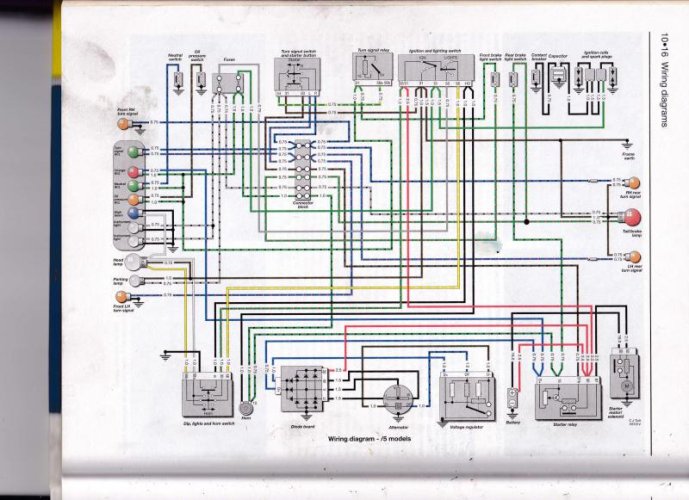brook.reams
B Reams
Folks,
I put together a series of documents about BMW airhead motorcycle electrical systems. It strikes me that electricity in general, and motorcycle electrics in particular, are dark mysteries to many, so I thought I'd shine some light [puns intended ].
].
Lack of understanding hinders confidence when diagnosing and working on electrical projects. As these bikes age, the electrical system is prone to problems as corrosion and neglect makes them behave badly. More owners are having more electrical problems but seem less able to get to the root cause of the problem.
I think one tool that many avoid using is the wiring diagram. The spaghetti of lines, symbols and notations makes the eyes glaze over. "Oh goodness, where do I start?" is the common response to the advice, "Look at the wiring diagram."

5 Series Wiring Diagram (1970-1973) (Source: Haynes Manual)
I'm not an electrical engineer, but I have taken time to learn the basics, have collected comments and input from well respected airhead mechanics and dug into how BMW applied electrical theory when they designed the /5 electrical system. I've learned a lot from various reference sources that are scattered about the internet, so my articles include a bibliography of various useful resources. That way both you and I have a nice set of reference materials to consult when problems come up.
I have published three articles (so far), Basics and two others about the /5 series: 5 Series Circuits and, 5 Series Electrical Components. I chose the /5 series to start with because I believe it's the most popular airhead series for restoration.
Here are links to the documents which also appear on the index on the right side of the blog pages.
I hope to write an Electrical Circuits and Electrical Components document for the /6 and /7 series up to 1984.
I hope this is helpful.
I put together a series of documents about BMW airhead motorcycle electrical systems. It strikes me that electricity in general, and motorcycle electrics in particular, are dark mysteries to many, so I thought I'd shine some light [puns intended
Lack of understanding hinders confidence when diagnosing and working on electrical projects. As these bikes age, the electrical system is prone to problems as corrosion and neglect makes them behave badly. More owners are having more electrical problems but seem less able to get to the root cause of the problem.
I think one tool that many avoid using is the wiring diagram. The spaghetti of lines, symbols and notations makes the eyes glaze over. "Oh goodness, where do I start?" is the common response to the advice, "Look at the wiring diagram."

5 Series Wiring Diagram (1970-1973) (Source: Haynes Manual)
I'm not an electrical engineer, but I have taken time to learn the basics, have collected comments and input from well respected airhead mechanics and dug into how BMW applied electrical theory when they designed the /5 electrical system. I've learned a lot from various reference sources that are scattered about the internet, so my articles include a bibliography of various useful resources. That way both you and I have a nice set of reference materials to consult when problems come up.
I have published three articles (so far), Basics and two others about the /5 series: 5 Series Circuits and, 5 Series Electrical Components. I chose the /5 series to start with because I believe it's the most popular airhead series for restoration.
Here are links to the documents which also appear on the index on the right side of the blog pages.
I hope to write an Electrical Circuits and Electrical Components document for the /6 and /7 series up to 1984.
I hope this is helpful.




